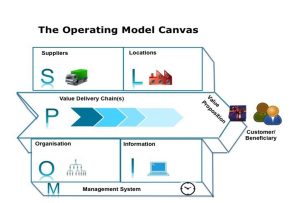To succeed in the ever-evolving world of service management organisations need a clear roadmap to navigate the landscape to achieve true transformation. Enter the Target Operating Model (TOM) – a powerful tool that outlines the desired future state of your service operations.
This blog post explores what a TOM is, why it’s crucial for successful service management transformation, and how you can leverage it in your organisation.
What Exactly is a TOM?
At its core, a Target Operating Model provides a blueprint for how your service management function will operate. It’s not just about processes; it encompasses all the critical elements that make service delivery effective. A TOM considers:
- Suppliers & Stakeholders: Identifying key partners and those invested in your services.
- Locations: Understanding where work is delivered and received.
- Processes & Value Chains: Defining the essential workflows and end-to-end activities.
- Customer & Service Delivery: Clearly outlining expectations and Service Level Agreements (SLAs).
- People & Organization: Defining roles, team structures, and responsibilities.
- Technology & Tools: Identifying the systems and technologies in use.
- Data & Information: Determining what data is crucial and how it will be managed.
- Governance & Controls: Establishing decision-making processes and performance monitoring mechanisms.

Think of it as a comprehensive model visually representing how these pieces interact to deliver value.
Why embrace a TOM for service management transformation?
Why should your organisation invest time and effort in developing a TOM? The benefits are significant:
- Provides Clarity and Alignment: A TOM creates a shared understanding of the desired future state across the organisation.
- Identifies Gaps and Opportunities: By comparing your current “As-Is” state with the “To-Be” TOM, you can pinpoint areas for improvement and innovation.
- Facilitates Strategic Planning: The TOM is a foundation for developing a clear transformation roadmap with defined milestones.
- Drives Accountability: Assigning ownership for different aspects of the TOM ensures that changes are driven effectively.
- Enhances Communication: Visual models and narratives built around the TOM help communicate the transformation’s vision and progress.
A TOM provides the structure and direction needed to move from where you are now to where you want to be in your service management journey.
How does a TOM work in practice?
At Barclay Rae Consulting, we follow a practical and iterative approach to leveraging a TOM for transformation, with a strong emphasis on organizational change management throughout the process:
- Start by documenting all current service operations which we call “As-Is.” Then, define your desired future state (“To-Be”) using the comprehensive elements of the TOM. This side-by-side comparison is foundational and helps to articulate the scope of the cultural and operational shifts required.
- Identify Gaps and Opportunities: Analyse the differences between your “As-Is” and “To-Be” models. This analysis will uncover areas needing attention, potential improvements, and innovation opportunities. Crucially, this step also identifies the specific people-related changes needed – new roles, skill gaps, or adjustments to team structures.
- Develop a Transition Plan: Create a detailed plan outlining clear milestones and achievable short-term wins to guide your transformation journey. This plan should integrate organisational change management practices, communication strategies, training programs, and stakeholder engagement plans, to prepare the workforce for the new TOM.
- Assign Owners: Ensure accountability by assigning individuals or teams to champion specific change areas identified within the TOM. These owners become key agents of change, responsible for driving adoption and addressing resistance.
- Develop Supporting Documentation: Create visual representations, diagrams, and other documentation that clearly illustrate the TOM. These visuals are powerful tools for shared understanding and consensus-building, making your TOM tangible and relatable.
- Build a Narrative: Craft a compelling story that explains how all the TOM elements fit together and contribute to the overall vision of your service management transformation. A strong narrative is critical for motivating people and securing buy-in, explaining “why” the change is necessary and “what’s in it for them.”
- Socialise and Iterate: Share the TOM and its narrative with all relevant stakeholders. Actively gather feedback and make necessary adjustments. This iterative process ensures that the TOM remains relevant and that people feel heard and involved in its development.
- Keep Refining: Your TOM is not a static document. It should be revisited and updated regularly as your organisation evolves, its needs change, and new technologies emerge.

Tips to Follow for a Successful TOM
The following tips and considerations will help you navigate your TOM journey:
- Start with Business Outcomes — Always begin by defining what success looks like from a business perspective (e.g., improved uptime, faster deployments, reduced incident resolution time).
- Engage Stakeholders Early — Involve IT, business leaders, and end-users to gather requirements, build support, and align on priorities.
- Use Visual Tools — Use process maps, capability models, and TOM diagrams to simplify communication and make complex systems understandable.
- Tailor the TOM to Your Context — There’s no one-size-fits-all TOM. Customize the model to suit your organization’s size, maturity, and technology landscape.
- Align With ITSM Frameworks — Integrate TOM design with established frameworks like ITIL 4, COBIT, or ISO/IEC 20000 for best practices in service management.
- Prioritize Capabilities — Focus on a small number of high-impact capabilities first (e.g., incident management, change control) before trying to redesign everything.
- Use a Phased Approach — Implement the TOM in stages to manage change effectively and reduce risk. Begin with pilots or proof-of-concept areas.
- Embed Metrics and KPIs — Define how success will be measured. Use KPIs to track performance of services, processes, and user satisfaction over time.
- Plan for People Change — A TOM is not just about tools. Include training, communication, and organizational change to support new roles and ways of working.
- Keep It Live — Don’t treat the TOM as a one-time exercise. Review and evolve it regularly to respond to changes in technology, customer expectations, or business strategy.
Pitfalls to Avoid
As well as understanding tips for success, it’s also crucial to know in advance what can derail your TOM initiative. These are the five most common pitfalls you want to avoid:
- Lack of Executive Sponsorship
- No clear leadership or ownership of the TOM initiative.
- Failure to align with business strategy or secure C-level support.
- Limited accountability for delivering outcomes.
- Treating TOM as a One-Time Project
- Assuming TOM is a static document, not a living framework.
- No plan for ongoing review, adaptation, or optimisation.
- Ignoring evolving business needs and external changes.
- Overcomplicating the Design
- Creating overly complex diagrams or models that are hard to understand.
- Trying to change too much at once without prioritisation.
- Losing sight of user experience and operational practicality.
- Neglecting People and Culture
- Failing to engage and communicate with impacted teams.
- Overlooking training, role clarity, and organisational change management.
- Underestimating resistance to change from employees.
- No Clear Link to Measurable Outcomes
- Missing KPIs or success metrics to track progress.
- Lack of alignment between TOM outcomes and business performance.
- Delivering outputs (e.g., new structure) without real impact (e.g., service quality)
Getting Started with Your TOM
While creating a comprehensive TOM might seem daunting, remember that you can start simple. Consider building your own basic version or using graphics to illustrate your initial thoughts. The key is to define your desired future state and use that as a guide for your transformation efforts.
And, remember that a TOM is fundamentally about creating a shared visualization to build consensus and align on common goals and structures, with a strong focus on the people, culture, and organizational change management (OCM) aspects of transformation.
A Target Operating Model is indispensable for any organisation’s service management transformation. By providing a clear framework, facilitating strategic planning, and enhancing communication, a well-defined TOM paves the way for successful and sustainable improvement.
Need help getting started? Get in touch to see how we can help.




